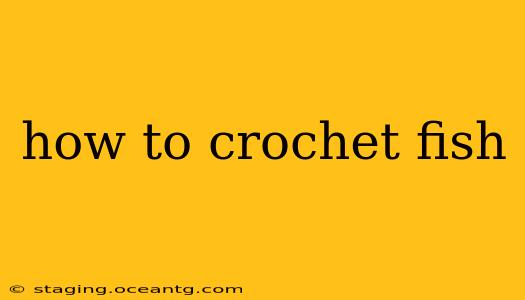Learning how to crochet fish is a delightful journey into the world of amigurumi, offering adorable creations perfect for home décor, gifts, or even keychains. This comprehensive guide covers various techniques and complexities, ensuring you'll find the perfect pattern to match your skill level, whether you're a complete beginner or an experienced crocheter.
What You'll Need to Crochet Fish
Before diving into the patterns, let's gather our essential supplies:
- Yarn: Choose yarn in colors that suit your vision for your fish. Cotton or acrylic yarn works well for amigurumi projects. Consider the weight of the yarn; lighter weight yarns require smaller hooks and create finer details.
- Crochet Hook: Select a crochet hook size appropriate for your chosen yarn weight. The yarn label usually provides recommendations.
- Scissors: For snipping yarn ends.
- Yarn Needle: For weaving in loose ends.
- Stuffing: Polyester fiberfill is ideal for stuffing your crocheted fish.
- Safety Eyes (Optional): These add a charming touch to your finished fish.
- Pattern: Choose a pattern that matches your skill level. Numerous free and paid patterns are available online and in crochet books.
Choosing Your First Fish Crochet Pattern
The complexity of crocheting a fish depends largely on the pattern. Beginner patterns typically involve simple stitches like single crochet (sc) and increases/decreases, while more advanced patterns may incorporate more intricate stitches like double crochet (dc), slip stitch (sl st), or even textured stitches.
H2: What are some easy crochet fish patterns for beginners?
Many websites and books offer easy-to-follow patterns for beginners. Look for patterns that use only basic stitches and provide clear instructions and diagrams. Search online for "easy crochet fish amigurumi" to find a variety of options. Pay attention to the pattern's difficulty level indicated by the designer.
H2: How do I crochet the different parts of a fish (body, tail, fins)?
Most fish patterns break down the creation into distinct parts: the body, tail, and fins. The body is usually crocheted in rounds, starting with a magic ring or a foundation chain. Increases and decreases are used to shape the body, creating the fish's curves. The tail and fins are often crocheted separately and then attached to the body. Each part will have its own set of instructions within the chosen pattern.
H2: What kind of yarn is best for crocheting fish?
Cotton or acrylic yarns are excellent choices for crocheting fish. Cotton offers a nice drape and is durable, while acrylic is often more affordable and comes in a wider array of colors. The yarn weight (indicated on the label) will influence the size of your hook and the final size of your fish.
H2: How do I make my crocheted fish look realistic?
Achieving realism depends on several factors:
- Yarn Choice: Using yarns with subtle color variations can add depth and realism.
- Stitch Choice: Experiment with different stitches to create texture and dimension.
- Embellishments: Adding details like gills, scales (using additional stitches or embroidery), or even a simple mouth can significantly enhance the realism.
- Positioning: Thoughtfully arranging the fins and tail will help your fish appear more lifelike.
H2: What are some tips for crocheting small fish?
Crocheting small fish requires precision and attention to detail. Use a smaller hook and lighter weight yarn. Work slowly and carefully, ensuring your stitches are even. You might find it helpful to use a stitch marker to keep track of your rounds.
Beyond the Basics: Advanced Crochet Fish Techniques
Once you've mastered basic fish patterns, you can explore more advanced techniques:
- Intarsia: This technique involves using multiple colors of yarn to create intricate patterns within the fish’s body.
- Mosaic Crochet: Similar to intarsia, but utilizes different color changes across the rounds.
- Surface Crochet: Adding details to the finished fish with surface crochet stitches for additional texture and realism.
With practice and patience, you’ll be crocheting delightful and intricate fish in no time. Remember to always follow the pattern instructions carefully and don’t be afraid to experiment and adapt the techniques to your own creative style. Happy crocheting!
